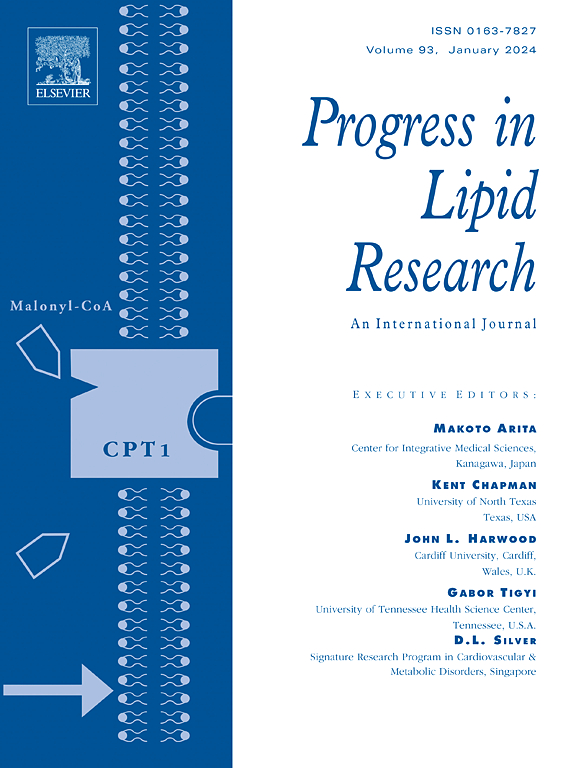How active cholesterol coordinates cell cholesterol homeostasis: Test of a hypothesis
IF 14
1区 医学
Q1 BIOCHEMISTRY & MOLECULAR BIOLOGY
引用次数: 0
Abstract
How do cells coordinate the diverse elements that regulate their cholesterol homeostasis? Our model postulates that membrane cholesterol forms simple complexes with bilayer phospholipids. The phospholipids in the plasma membrane are of high affinity; consequently, they are fully complexed with the sterol. This sets the resting level of plasma membrane cholesterol. Cholesterol in excess of the stoichiometric equivalence point of these complexes has high chemical activity; we refer to it as active cholesterol. It equilibrates with the low affinity phospholipids in the intracellular membranes where it serves as a negative feedback signal to a manifold of regulatory proteins that rein in ongoing cholesterol accretion. We tested the model with a review of the literature regarding fourteen homeostatic proteins in enterocytes. It provided strong albeit indirect support for the following hypothesis. Active cholesterol inhibits cholesterol uptake and biosynthesis by suppressing both the expression and the activity of the gene products activated by SREBP-2; namely, HMGCR, LDLR and NPC1L1. It also reduces free cell cholesterol by serving as the substrate for its esterification by ACAT and for the synthesis of side-chain oxysterols, 27-hydroxycholesterol in particular. The oxysterols drive cholesterol depletion by promoting the destruction of HMGCR and stimulating sterol esterification as well as the activation of LXR. The latter fosters the expression of multiple homeostatic proteins, including four transporters for which active cholesterol is the likely substrate. By nulling active cholesterol, the manifold maintains the cellular sterol at its physiologic set point.
活性胆固醇如何协调细胞胆固醇平衡:假设检验
细胞如何协调调节胆固醇平衡的各种因素?我们的模型假设,膜胆固醇与双层磷脂形成简单的复合物。质膜中的磷脂具有高亲和力,因此能与固醇充分结合。这就确定了质膜胆固醇的静止水平。超过这些复合物的化学当量点的胆固醇具有很高的化学活性,我们称之为活性胆固醇。它与细胞内膜中的低亲和力磷脂达到平衡,在细胞内膜中作为负反馈信号传递给多种调节蛋白,从而控制胆固醇的持续增加。我们对有关肠细胞中 14 种平衡蛋白的文献进行了回顾,以检验该模型。尽管是间接的,但它为以下假设提供了强有力的支持。活性胆固醇通过抑制 SREBP-2 激活的基因产物(即 HMGCR、LDLR 和 NPC1L1)的表达和活性来抑制胆固醇的摄取和生物合成。它还通过作为 ACAT 对游离细胞胆固醇进行酯化的底物,以及作为合成侧链氧基甾醇(尤其是 27-羟基胆固醇)的底物,减少游离细胞胆固醇。氧杂环醇通过促进 HMGCR 的破坏、刺激固醇酯化和 LXR 的激活来消耗胆固醇。后者会促进多种平衡蛋白的表达,包括四种转运体,而活性胆固醇可能是它们的底物。通过抑制活性胆固醇,歧管将细胞固醇维持在生理设定点。
本文章由计算机程序翻译,如有差异,请以英文原文为准。
求助全文
约1分钟内获得全文
求助全文
来源期刊

Progress in lipid research
生物-生化与分子生物学
CiteScore
24.50
自引率
2.20%
发文量
37
审稿时长
14.6 weeks
期刊介绍:
The significance of lipids as a fundamental category of biological compounds has been widely acknowledged. The utilization of our understanding in the fields of biochemistry, chemistry, and physiology of lipids has continued to grow in biotechnology, the fats and oils industry, and medicine. Moreover, new aspects such as lipid biophysics, particularly related to membranes and lipoproteins, as well as basic research and applications of liposomes, have emerged. To keep up with these advancements, there is a need for a journal that can evaluate recent progress in specific areas and provide a historical perspective on current research. Progress in Lipid Research serves this purpose.
 求助内容:
求助内容: 应助结果提醒方式:
应助结果提醒方式:


